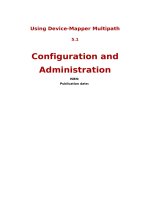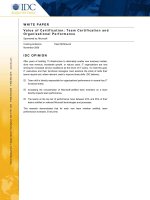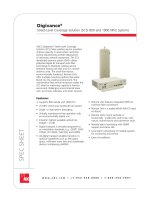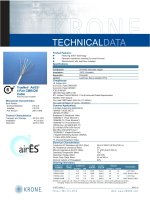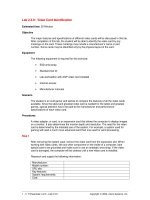Tài liệu CCIE_Train-01(2) ppt
Bạn đang xem bản rút gọn của tài liệu. Xem và tải ngay bản đầy đủ của tài liệu tại đây (116.73 KB, 24 trang )
Table of contents
Exercise 1) Remote frame relay switching 2
Exercise 2) IP across frame relay 3
Exercise 3) IPX across frame relay 4
Exercise 4) Appletalk across frame relay 5
Exercise 5) Decnet across frame relay 6
Exercise 6) Banyan vines across frame relay 7
Exercise 7) Trouble shoot your network 8
Exercise 8) DLCI prioritization 9
Exercise 9) Stun and X.25 10
Exercise 10) Hot standby router protocol (HSRP) 11
Exercise 11) Advanced bgp-4 12
Exercise 12) EIGRP 13
Exercise 13) IPX 14
Exercise 14) Auto install 15
Exercise 15) IGRP-BGP-OSPF 16
Exercise 16) Policy routing 17
Exercise 17) Network Address Translation 18
Exercise 18) Protocol translation 19
Exercise 19) Route tagging 20
Exercise 20) CLNS and IS-IS 21
Exercise 21) DLSW+ 22
Exercise 1) Remote frame relay switching
Objective: The objective of this exercise is configure Sydney and Melbourne
(refer diagram 1) for remote frame relay switching. As such they will tunnel
frame relay traffic between the 2 serial0 interfaces by encapsulating this traffic
in IP and sending it across an IP backbone.
a) Cable your routers as shown on diagram 1. Gibe all 4 routers appropriate
hostnames and passwords. Also add clocking on serial interfaces. Do NOT
clock faster then 38.4kbps if you have V.24 cables.
b) Use network 131.108.0.0 and a /20 mask to create 3 subnets.
c) Configure Sydney and Melbourne Ethernet0 for IP routing using of the
allocated subnets.
d) Create one loopback interface on each of Melbourne and Sydney, and
assign each an IP address from the remaining 2 subnets.
e) On Sydney and Melbourne configure RIP to advertise network 131.108.0.0
f) Create a tunnel connecting Melbourne and Sydney across the Ethernet IP
backbone, Use the loopback interfaces as end points.
g) Configure Melbourne and Sydney as frame relay (FR) switches on serial 0.
Create 2 PVC’s at each end. Assign them DLCI numbers 50 and 51.
h) Connect Brisbane/Canberra to Melbourne/Sydney via their serial 0. Create 2
PVC’s between Brisbane and Canberra. Use a NBMA approach, ie. No
subinterfaces.
i) Use Cisco LMI signaling between Brisbane and Melbourne. Use ANSI
signaling between Sydney and Canberra.
j) Configure Brisbane/Canberra to poll the switches every 5 seconds.
k) Use show frame-relay pvc to verify that both DLCI’s are active between
Brisbane and Canberra.
Exercise 2) IP across frame relay
Objective: The objective of this exercise is configure Brisbane and Canberra for
IP connectivity across the frame relay service established in the previous
exercise. This will be an OSPF network.
a) Create one loopback interface on each of Brisbane and Canberra. Configure
IP routing on both the loopback interface and frame relay interface. Use
192.1.1.0 with a /26 mask to allocate the appropriate IP addressing.
b) Use a frame relay map statement to map between next hot IP address and
DLCI on Brisbane and Canberra. Map DLCI 50 only. It is necessary to turn
off inverse ARP for all protocols, to avoid DLCI’s going up and down.
c) Configure Brisbane and Canberra for OSPF. Make the FR cloud the
backbone area. Put the loopback interface on Brisbane in area 1 and the
loopback interface on Canberra in area 2.
d) Force the backup designated router to become the designated router on the
FR cloud. Use show IP OSPF int s0 verifies your result.
e) Verify that Brisbane can IP ping the loopback interface on Canberra. Can
Brisbane ping the Ethernet interface on Sydney? Is this the result you
expected?
Exercise 3) IPX across frame relay
Objective: The objective of this exercise is to configure Brisbane and Canberra
for IPX connectivity across the frame relay service established in the initial
exercise. This network will use EIGRP/IPX as the routing protocol.
a) Configure IPX addressing on the loopback and frame relay interfaces of
Canberra and Brisbane. Use the following addressing:
Router Interface IPX network
Brisbane loop0 10
Brisbane s0 20
Canberra loop0 30
Canberra s0 20
b) Use a frame relay map statement to map between next hop IPX address
and DLSI on Brisbane and Canberra. Map DLCI 50 only. Do not use inverse
ARP.
c) Configure the network for EIGRP/IPX.
d) Configure a static SAP on loopback interface of Brisbane. Verify that it is
visible on Canberra.
e) Verify that Brisbane can IPX ping the loopback interface on Canberra.
Exercise 4) Appletalk across frame relay
Objective: The objective of this exercise is to configure Brisbane and Canberra
for Appletalk connectivity across the frame relay service established in the initial
exercise. For the sake of variety we will tunnel the Appletalk across the frame
relay cloud using generic route encapsulation (GRE) over IP.
a) Connect Brisbane and Canberra via a TCP/IP tunnel. Use the loopback
interfaces as tunnel endpoints.
b) Configure Appletalk (AT) cable-ranges and zones on the tunnel interfaces of
Brisbane and Canberra. Use GRE encapsulation. Appletalk does not work
on loopback interface so configure Appletalk on the ethernet0 interfaces
instead, but turn off keep alives to force the line protocol up.
Router Interface Cable range Zone
Brisbane ether0 10-10 QLD
Brisbane tunnel0 20-20 Australia
Canberra tunnel0 20-20 Australia
Canberra ether0 30-30 ACT
c) Verify that Brisbane can Appletalk ping the ethernet0 interface on Canberra,
and vice versa.
Exercise 5) DecNet across frame relay
Objective: The objective of this exercise is to configure Brisbane and Canberra
for DecNet connectivity across the frame relay service established in the initial
exercise. Brisbane and Canberra will be in different DecNet areas.
a) Configure DecNet on Brisbane and Canberra. Use the following addressing
Router Area Node
Brisbane 10 1
Canberra 30 1
b) Use a frame relay map statement to map between next hop DecNet address
and DLCI on DLCI 50.
c) Verify that Brisbane can DecNet ping Canberra, and vice versa.
Exercise 6) Banyan vines across frame relay
Objective: The objective of this exercise is to configure Brisbane and Canberra
for Banyan Vines connectivity across the frame relay service established in the
initial exercise.
a) Configure Banyan Vines on Brisbane and Canberra. Enable vines on both
loopback and serial interfaces.
b) Use a frame relay map statement to map between next hop Bines address
and DLCI on DLCI 50.
c) Verify that Brisbane can Vines ping Canberra, and vice versa.
Exercise 7) Troubleshoot your network
Objective: The objective of this exercise is to troubleshoot the network that you
have created so far. This is a simulation of what you will be asked to do at the
real CCIE lab.
a) Verify that you have end-to-end connectivity for IP, IPX, AT, DecNet and
Vines. This working network is now baseline.
b) Leave the room while your instructor inserts 6 trouble tickets into your
network.
c) When asked to return, troubleshoot your network and bring it back to
baseline. You have max 2 hours to complete this exercise.
While troubleshooting, document your approach. As an absolute minimum list
the problems you find, some suspected causes, and the actual fault once you
find it. At the CCIE lab you will be given credit for this documentation, even if
you do not manage to resolve all problems.
Exercise 8) DLCI prioritization
Objective: The objective of this exercise is to configure DLCI prioritization
between Brisbane and Canberra. Recall that 2 parallel DLCI’s connect these 2
routers. DLCI prioritization will control which traffic goes on which DLCI.
a) Now that you have regained full connectivity, configure DLCI prioritization on
both Brisbane and Canberra so that:
- Telnet traffic is given high priority.
- Traffic to TCP port ‘daytime’ is given low priority.
- Everything else is given medium priority.
b) Put high and medium traffic on DLCI 50. Put the normal and low traffic on
DLCI 51.
c) Verify your configuration by turning on ‘debug priority’ and ‘debug frame
relay packet’. From Brisbane telnet to the daytime port on Canberra (telnet
Canberra daytime). Examine the debug output to verify that traffic is sent
down DLCI 51 only when you telnet to daytime.
Exercise 9) STUN and X.25
Objective: The objective of this exercise is to configure X.25 between Brisbane
and Canberra. Because these 2 routers are separated by Sydney and
Melbourne we will configure Sydney and Melbourne to STUN the X.25 across.
a) Reconfigure the serial ports on Melbourne and Sydney for STUN. Tunnel in
basic mode between the 2 serial interfaces using TCP/IP encapsulation.
b) Reconfigure the serial0 interfaces on Brisbane and Canberra for X.25.
Canberra and Brisbane will appear as if they are running X.25 back to back,
so make Brisbane X.25 DCE.
c) Configure the X.25 interfaces with the following characteristics:
- Brisbane X.121 address is 11111
- Canberra X.121 address is 22222
- Use a single SVC to carry multiprotocol traffic (RFC-1356)
- Use virtual circuit number 53 as a two way multiprotocol SVC
- Incoming/outgoing packet size of 1024 bytes
- Incoming/outgoing window of 7
d) Add the necessary X.25 map statements to make the existing IP, IPX, AT,
DecNet and Vines configuration on the Canberra and Brisbane work across
the X.25 cloud. Use Multiprotocol encapsulation (RFP 1356)
e) Verify that IP, IPX, Appletalk, DecNet and Vines all work by pinging from
Brisbane to Canberra.
Exercise 10) Hot standby router protocol (HSRP)
Objective: The objective of this exercise is to configure HSRP on the Ethernet
connecting Sydney and Melbourne. HSRP is a hot feature that ensures that end
systems configured with a default gateway do not loose remote connectivity just
because their default router becomes unavailable.
a) Configure HSRP on Melbourne and Sydney. Hint: use the ‘standby’
command.
b) Configure Melbourne to become the active default gateway, by giving it a
better priority. Use ‘show standby’ to verify the result.
c) Shutdown Melbourne ethernet0 and verify that Sydney becomes the active
default gateway. Use ‘show standby’ and ‘debug standby’ to verify this.
d) Reenable Melbourne ethernet0
Exercise 11) Advanced BGP-4
Objective: The objective of this exercise is to configure an advanced BGP
network. This BGP network will connect 3 autonomous systems using external
BGP. Autonomous system 2 will also use internal BGP. By configuring a route
filter you will force a certain BGP route to be used to reach a specific network.
You will also configure route summarization, which in BGP is referred to as
Classless Inter Domain Routing (CIDR). Warning: BGP is a CCIE lab favorite.
a) Connect the 2 ethernet0 interfaces on Brisbane and Canberra.
b) Erase the existing configuration on all routers.
c) Give all 4 routers appropriate hostnames and passwords. Add clocking to
the appropriate serial interfaces.
d) Add IP addressing to match the following numbering plan:
Router Interface Network Mask
Brisbane Loopback0 131.129.0.0 /16
Brisbane Loopback1 131.130.0.0 /16
Brisbane Ethernet0 131.108.0.0 /16
Brisbane Serial0 131.109.0.0 /16
Melbourne Serial0 131.109.0.0 /16
Melbourne Ethernet0 131.110.0.0 /16
Sydney Serial0 131.111.0.0 /16
Sydney Ethernet0 131.110.0.0 /16
Canberra Serial0 131.111.0.0 /16
Canberra Ethernet0 131.108.0.0 /16
e) Configure Internal BGP between Sydney and Melbourne. Configure External
BGP between Brisbane/Melbourne, Brisbane/Canberra and
Canberra/Sydney. Use the following autonomous system numbers:
Router Autonomous System
Brisbane 1
Melbourne 2
Sydney 2
Canberra 3
f) Because we have no interior routing protocol configured it is necessary to
add ‘no synchronization’ to the BGP configuration on Sydney and Melbourne.
g) Use ping to verify that you have full connectivity between all networks.
h) Configure route summarization o Brisbane so the 2 loopback interfaces are
advertised as one CIDR route. Suppress the non-summary routes.
i) Configure an input route filter on Melbourne so that Melbourne ignores the
BGP update from Brisbane advertising the loopback interfaces. This will
force Melbourne to use the second best route-to-route traffic to these
networks, i.e. send it via Sydney.
j) Verify that Melbourne now routes traffic to Brisbane’s loopback interface by
sending it via Sydney. Use ‘trace’ or examine the routing table.
Exercise 12) EIGRP
Objective: The objective of this exercise is to configure EIGRP is a network that
has dissentious IP subnets. You will also be asked to configure route
summarization for EIGRP.
a) Retable your routers to match diagram 2. Erase all existing configs.
b) Give all 4 routers appropriate hostnames and passwords. Add clocking to
the appropriate serial interfaces.
c) Reenable IP routing on Sydney and Melbourne.
d) Change existing IP addressing to match the following numbering plan:
- Ethernet between Brisbane and Melbourne is 131.108.128.0 /24
- Loopback0 interface on Brisbane is 131.108.129.0 /24
- Serial0 between Melbourne and Sydney is 131.109.0.0 /30
- Ethernet between Sydney and Canberra is 131.108.64.0 /24
- Loopback0 interface on Canberra is 131.108.65.0 /24
Notice the disconfigious subnets.
e) Turn on EIGRP for IP on all 4 routers. Use autonomous system number 200.
f) Configure EIGRP for appropriate route summarization.
Exercise 13) IPX
Objective: The objective of this exercise is to tune an IPX network, perform IPX
route filtering and configure an IPX static route.
a) Configure IPX addressing to match the following numbering plan:
- Ethernet between Brisbane and Melbourne is ‘c0ffee’
- Loopback0 interface on Brisbane is ‘beef’
- Serial0 between Melbourne and Sydney is ‘12345678’
- Ethernet between Sydney and Canberra is ‘babe’
- Loopback0 interface on Canberra is ‘bead’
b) Configure static SAP on loopback interface of Canberra.
c) Tune timers on the serial links so:
- SAP update interval is 240 seconds
- RIP update interval is 120 seconds
- SAP pacing is 0 msec
d) Use ‘show ipx interface’ to verify that timers are set as expected.
e) Configure an IPX route filter on Sydney so ‘c0ffee’ is NOT advertised to
Canberra. Verify that Canberra is unable to IPX ping the ‘c0ffee’ network.
f) Configure an IPX static roué to ‘c0ffee’ on Canberra. Verify that Canberra is
able to IPX ping the ‘c0ffee’ network.
Exercise 14) Auto install
Objective: The objective of this exercise is autoinstall a Cisco router via SLARP
and a TFTP server.
a) Ask the instructor for a Trumpet Winsock disk if not already installed on your
PC. Startp TCPMAN.EXE. Pull down the ‘file’ menu and select ‘Setup’.
Configure Trumpet to use PPP, COM1 and 38400bps.
b) Configure the auxiliary port on Brisbane as follows:
- Dedicated mode
- IP unnumbered
- 38400 bps. 8N1
- Default IP address from one of the loopback interfaces.
- PPP encapsulation
c) Start the TFTF server (LOADER.EXE)
d) Verify that you can ping the TFTP server from Sydney
e) Copy Sydney’s running configuration to the TFTP server. Save it as
SYDNEY.CFG
f) Create file CISCONET.CFG on the TGTP server. In this file add an ‘ip host
sydney’ entry with the IP address that Sydney will acquire from Melbourne
via SLARP.
g) Add an IP helper address on Melbourne serial0 that points to the TFTP
server.
h) Erase the configuration on Sydney, and power cycle the router.
i) Verify that Sydney successfully auto installs from the TFTP server.
Exercise 15) IGRP - BGP - OSPF
Objective: The objective of this exercise is interconnect 2 autonomous systems
via BGP. AS1 consists of Brisbane and Melbourne, and uses OSPF as the
interior routing protocol. Melbourne is the BGP speaker. AS2 consists of
Sydney and Canberra, and uses IGRP as the interior routing protocol. Sydney
is the BGP speaker. In AS1 Melbourne will advertise a default route via OSPF.
In AS2 Sydney will redistribute BGP into IGRP.
a) Change the IP addressing on your routers to match the following:
- Ethernet between Brisbane and Melbourne is 131.108.1.0 /24
- Loopback0 interface on Brisbane is 131.108.2.0 /24
- Loopback1 interface on Brisbane is 131.109.0.0 /16
- Serial0 between Melbourne and Sydney is 131.110.0.0 /30
- Serial1 between Melbourne and Sydney is 131.110.0.0 /30
- Ethernet between Sydney and Canberra is 131.111.0.0 /24
b) Configure external BGP on Sydney and Melbourne. Make Melbourne
advertise networks 131.108.0.0 and 131.109.0.0 Make Sydney advertise
131.111.0.0.
c) Brisbane and Melbourne make up AS1. Configure OSPF on these 2 routers.
d) Configure Melbourne to advertise a default route via OSPF.
e) Canberra and Sydney make up AS2. Configure IGRP on these 2 routers.
f) Configure Sydney to redistribute all BGP routes in IGRP.
g) Verify that Canberra can ping both loopback interfaces on Brisbane.
h) Add a route filter to Sydney so 131.109.0.0 does not get redistributed into
IGRP.
i) Verify that Canberra can ping loopback0 on Brisbane, but not loopback1.
Exercise 16) Policy routing
Objective: The objective of this exercise is to configure policy routing on
Melbourne as follows: Packets with a source address of Brisbane loopback0 are
sent down Melbourne serial0, packets with a source address of Brisbane
loopback1 are sent down Melbourne serial1.
a) Activate policy routing on Melbourne ethernet0.
b) Configure a route-map that routes packets with a source address of
Brisbane loopback0 down Melbourne serial0, and packets with a source
address of Brisbane loopback1 down Melbourne serial 1.
c) Verify that the policy is enforced by tracing Canberra from Brisbane.
Exercise 17) Network Address Translation
Reconfigure your network with IP addressing as follows:
Router Interface Network Mask
Brisbane e0 10.0.0.0 /24
Brisbane e0 10.0.0.0 /24
Brisbane s0 20.0.0.0 /30
Brisbane 20.0.0.0 /30
Melbourne 20.0.0.0 /24
Melbourne e0 20.0.0.0 /24
a) Configure address translation on Melbourne so that e0 is the inside network
and s0 is the outside network. Use 30.0.0.0 as the NAT address pool.
b) Configure OSPF as the routing protocol.
c) Configure a static route to 30.0.0.0 out interface null0 and redistribute into
OSPF.
d) Verify the configuration by tenting from Brisbane to Sydney. Do a ‘show
TCP’ on both Brisbane and Sydney and compare the IP addresses. Do a
‘show IP NAT trans’ on Melbourne.
Exercise 18) Protocol Translation
Objective: The objective of this exercise is to configure LAT to X.25 protocol
translation on Melbourne and X.25 to TCP protocol translation on Sydney, so
that Brisbane can connect to the exec on Canberra via a combined LAT. X.25
and TCP connection.
a) Enable Brisbane and Melbourne for LAT terminal services across their
connecting LAN. Verify that you can LAT from Brisbane to Melbourne.
b) Enable X.25 on serial0 between Melbourne and Sydney. Verify that you can
PAD from Melbourne to Sydney.
c) Configure one step LAT to X.25 protocol translation on Melbourne, so that
an incoming connection LAT connection is mapped to an outgoing X.25
connection and vice versa.
d) Configure one step X.25 to TCP protocol translation on Sydney, so that an
incoming connection x.25 connection is mapped to an outgoing TCP
connection and vice versa.
e) Verify that you successfully establish a LAT connection from Brisbane to
Canberra and that you can telnet from Canberra to Brisbane.
Exercise 19) Route Tagging
Objective: The objective of this exercise is to redistribute routes from IGRP to
OSPF and then to RIP. When redistribution from IGRP to OSPF routes are
tagged so that the metrics can be selectively set when the routes are later
redistributed into RIP.
a) Reconfigure your network with IP addressing as follows:
Router Interface Network Mask
Brisbane loop0 10.0.0.0 /8
Brisbane loop1 20.0.0.0 /8
Brisbane e0 131.108.0.0 /24
Melbourne e0 131.108.0.0 /24
Melbourne s0 131.108.0.0 /24
Sydney 131.108.0.0 /24
Sydney 131.108.0.0 /24
Canberra e0 131.108.0.0 /24
Canberra loop0 131.108.0.0 /24
b) Configure Brisbane for IGRP only. Configure Melbourne for IGRP and OSPF.
Configure Sydney for OSPF and RIP. Configure Canberra for RIP only.
c) On Melbourne redistribute routes between IGRP and OSPF. When
redistributing into OSPF tag network 10.0.0.0 with number 10 and 20.0.0.0
with number 20.
d) On Sydney redistribute routes between RIP and OSPF. When redistributing
into RIP set the hop count for networks with tag 10 to 5 and with tag 20 to 10
e) Verify that you have end to end connectivity and that the RIP metrics on
Canberra have the expected hop count.
Exercise 20) CLNS and IS-IS
Objective: The objective is to configure CLNS as a routed protocol and IS-IS as
the corresponding routing protocol. Brisbane and Melbourne will reside in area
1, While Sydney and Canberra will be in area 2.
a) Turn on CLNS/ISIS on each router, using the following NET’s:
Router NET
Brisbane 49.0000.0001.0000.0000.0001.00
Melbourne 49.0000.0001.0000.0000.0002.00
Sydney 49.0000.0002.0000.0000.0003.00
Canberra 49.0000.0002.0000.0000.0004.00
b) Verify that you can CLNS ping and trace from Canberra to Brisbane.
Exercise 21) DLSw+
Objective: The objective is to configure DLSw+ on Sydney and Melbourne
routers, and switch SNA frames between Brisbane and Canberra. In the
absence of real SNA devices we’ll configure Canberra and Brisbane for DSPU
support, which will provide us with LLC2 sessions to switch.
a) Configure DLSw+ on Sydney and Melbourne so that frames are switched
between the Sydney and Melbourne ethernets.
b) Without necessarily understanding what you are doing, configure DSOU in
Brisbane and Canberra by entering the following configuration:
Brisbane:
dspu host Canverra1 rmac 0200.0000.0001 retry-timeout 5 lsap 4
dspu host Canverra2 rmac 0200.0000.0001 retry-timeout 5 lsap 8
int e0
dspu enable-host lsap 4
dspu enable-host lsap 8
dspu start Canberra1
dspu start Canberra2
Canberra:
dspu host Non Existing rmac 0200.0000.0002 lsap 4
dspu dsfault-pu
dspu lu 2 3 host Non Existing 2
int e0
mac-address 0200.0000.0001
dspu enable-pu lasp 4
dspu enable-pu lasp 8
c) Use ‘show llc2’ on Brisbane and Canberra to verify that 2 LLC2 sessions are
being switched across the DLSw backbone.
d) Configure an LSAP output filter to the DLSw+ configuration on Melbourne so
that the LSAP=4 session is blocked.
e) Replace the LSAP output filter with an icannotreach statement that blocks
the LSAP=4 session.

